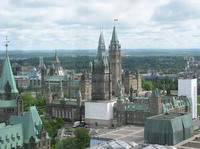Login form
Saskatchewan

Saskatchewan is known as the Wheat Province. It produces more wheat than any other province in Canada. Saskatchewan is one of Canada’s three Prairie Provinces, along with Manitoba and Alberta. Flat prairies extend as far as the eye can see in the southern part of these provinces.
|
Facts About Saskatchewan |
|
|
|
|
|
Capital |
Regina |
|
Population |
990,000 people |
|
Rank among provinces and territories in population |
6th |
|
Major cities |
Saskatoon, Regina |
|
Area |
251,000 square miles |
|
Rank among provinces and territories in area |
7th |
|
Entry into federation |
September 1, 1905 |
|
Provincial bird |
Sharp-Tailed Grouse |
|
Provincial flower |
Western Red Lily |
|
Abbreviation |
SK |
HILLS AND FLATLANDS
Plains and prairies cover most of Saskatchewan. They are broken in places by rolling hills. To the north are forests and thousands of lakes. The lakes were left behind by glaciers that once covered the region.
Prince Albert National Park is in the center of Saskatchewan. It’s an area of forests, lakes, streams, and marshes. Bison, ducks, and many other kinds of wildlife are found in the park. The park is proud of being one of the few places in the world where timber wolves live undisturbed.
Fertile soil and wheat fields cover much of southern Saskatchewan. Saskatchewan produces about half of the wheat grown in Canada.
Grasslands National Park is in southwestern Saskatchewan, on its border with the United States. It preserves shortgrass prairie and the plants and animals that thrive in this kind of environment.
REGINA AND SASKATOON
Most of Saskatchewan’s people live in the southern half of the province. Regina, Saskatchewan’s capital, is here. So is Saskatoon, its largest city.
Regina is a Latin word that means “queen.” The city was named in honor of Queen Victoria of Britain. Regina is sometimes called the Queen City of the Plains because of its central location in the Prairie Provinces.
Regina got its start as headquarters for the North-West Mounted Police (now the Royal Canadian Mounted Police). The Mounties—troops on horseback—were founded in 1873 to bring order to Canada’s wild west. Although the headquarters later moved, a training academy for the Royal Canadian Mounted Police remains in Regina. The city also has a museum that shows the Mounties’ role in taming Canada’s western frontier.
Saskatoon is north of Regina and is the business center for central Saskatchewan. The city lies on both sides of the Saskatchewan River. Seven bridges connect the two parts of the city.
On September 1, 1905, Saskatchewan was separated from Canada’s Northwest Territories. It became a province. Regina, which had been capital of the Northwest Territories, was named the capital of Saskatchewan.
FROM FUR TO FARMING
Fur trading was the first important business in Saskatchewan. The first trading post was set up in the area in 1774.
Saskatchewan was filled with bears, beavers, muskrats, and other fur-bearing animals. Traders traveled east toward Hudson Bay on the Saskatchewan River. The river’s name comes from the Cree Indian word for “swiftly flowing.” The word Saskatchewan was first used for the river that crosses the province.
Railroads reached Saskatchewan in the 1880s. After the railroad arrived, farming became important. Railroads brought in settlers to farm the land. They also carried wheat and other farm products to markets. Immigrants arrived from Britain, Germany, Hungary, Sweden, and Ukraine.
LAND OF PRAIRIE CATHEDRALS
Saskatchewan farmers used to haul their wheat to the nearest grain elevator. These tall buildings stored the grain and loaded it onto trains. The grain was carried by train to a port for shipping or a mill for processing.
The grain elevators became known as “prairie cathedrals” or “prairie skyscrapers.” Although they were simple structures, they soared skyward from the flat prairie and reminded people of churches. They became familiar sights near railroad stations in the Prairie Provinces. By the 1930s, Saskatchewan had more than 3,200 prairie cathedrals.
Today, only a few hundred grain elevators remain in Saskatchewan. Most farmers now use huge trucks to bring wheat to grain handling centers. These concrete handling centers hold 12 times more grain than the old elevators did. Many of the grain elevators have been destroyed. But people have begun to appreciate their beauty and their importance in North American history.
LAND OF THE LIVING SKIES
License plates in Saskatchewan call the province the Land of the Living Skies. There’s a lot of sky to see over the flat prairie. Saskatchewan also has beautiful sunsets, and it’s a good place to see the northern lights. These dancing streaks of colorful light sometimes brighten the northern night sky. They are also known as the aurora borealis.
Source: Microsoft ® Encarta

